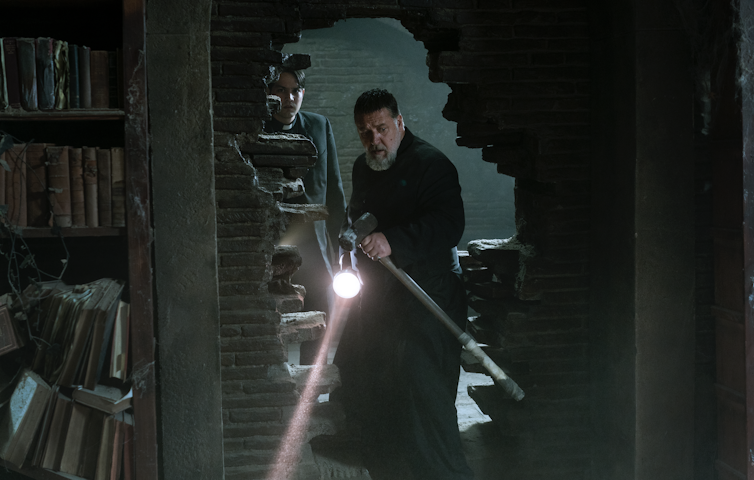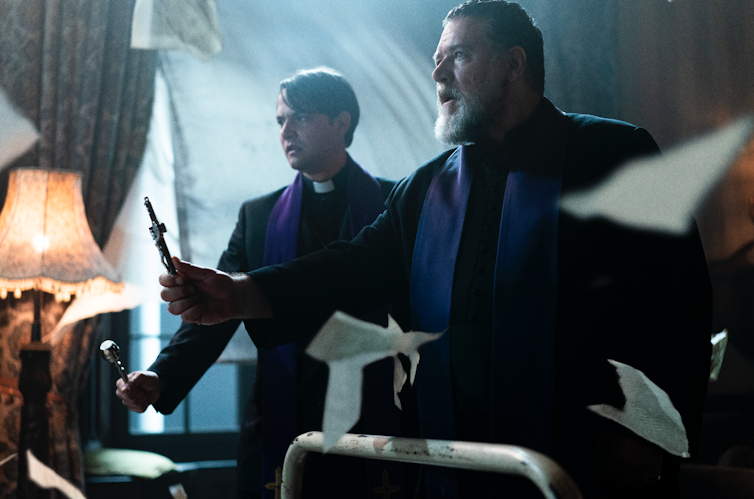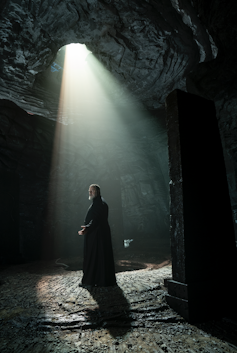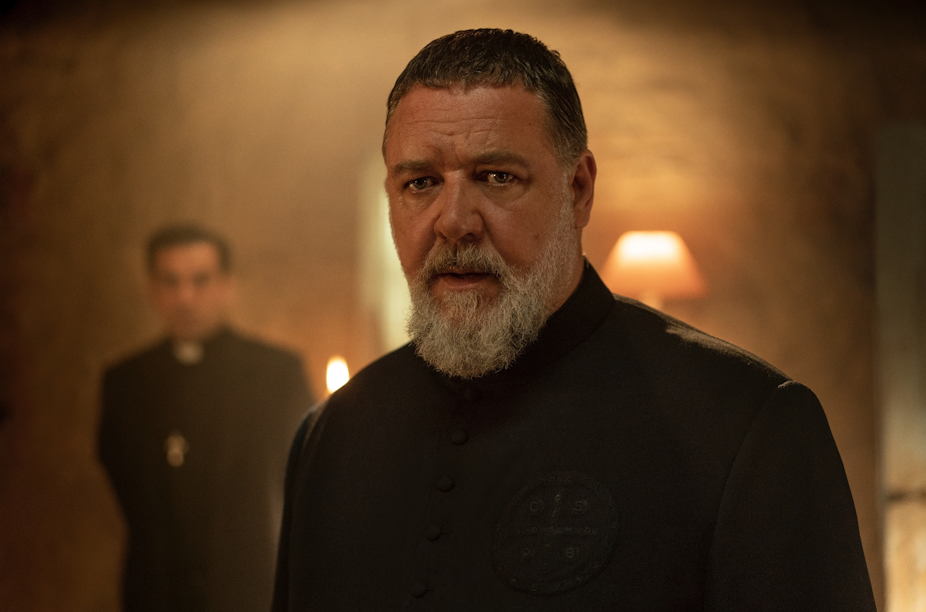When official trailers were released, the International Association of Exorcists branded The Pope’s Exorcist: “unreliable … splatter cinema”.
The film’s protagonist, Father Gabriele Amorth (Russell Crowe), is based on a real Catholic exorcist who was a founding member of the very organisation condemning the movie as inaccurate. So cinema-goers had fair warning that it would be far from uncontentious.
Promotional material for the film did not promise a reflection on exorcism in the modern era, but presented an Indiana Jones-style figure in a cassock, brandishing a crucifix instead of a whip.
The film itself lived up to both these fears and expectations. A classic fusion of action and horror, it fits squarely into the exorcist genre with levitation, twisting heads and gravelly-voiced demons speaking through the wracked bodies of helpless children.
The plot moves through some of Father Amorth’s most memorable reported cases, in particular a struggle with a demon the church had supposedly battled in previous centuries.
At times there are shades of the Da Vinci Code, with Vatican cover-ups, conspiracies and ecclesiastical power play. Add into the mix secret chambers hiding cobweb-strewn skeletons and dark secrets and it’s squarely in Temple of Doom territory.

Despite these obvious flights of fancy, there is a tension in not knowing exactly where the line between history and make believe is drawn, especially as the real Father Amorth died several years ago.
This aspect of the film struck a chord with my research on exorcism and the parameters the legal system draws around freedom of religion in this context. Pop-culture exorcisms attract a lot of media interest, but it can be harder to get traction for serious debate.
These Hollywood depictions can lead to real world dangers – as tragedies like the murder of Victoria Climbié in 2000 prove all too graphically. The eight-year-old was abused and killed by her great aunt and her great-aunt’s boyfriend, who used “demonic possession” to explain their niece’s injuries to their pastor.
How true to life is The Pope’s Exorcist?
Disentangling the real-world inspiration and fictional elements of The Pope’s Exorcist is complicated by differing perceptions of exorcism within the church.
The work of Father Amorth was controversial during his lifetime. The International Association of Exorcists took some time to gain papal endorsement from John Paul II. Even now it is recognised as a “private association of the Christian faithful” rather than a group coordinated by ecclesiastical authorities.
The current Pope Francis is faced with balancing contrasting understandings of exorcism within the church.

Some of the conflict arises from theological differences about the nature of evil and demons, while some is rooted in the cultural differences of the international church. The Pope’s Exorcist overtly deals with this. An African bishop (Cornell John) is portrayed as supportive of Father Amorth and a counterbalance to a sceptical American cardinal.
This taps into stereotypes from colonial era literature. There, communities regarded as “primitive” were depicted as more aligned to supernatural forces and therefore threatening.
In the works of authors such as Arthur Conan Doyle, Rudyard Kipling or Rider Haggard, there is the concession that other cultures might have access to lost knowledge and awareness, but this is generally viewed as a sinister rather than a positive trait.
Demons and the modern church
In the contemporary world, the Roman Catholic Church has to pay regard to the benefits of modern science and the empirical method. The church has even sometimes helped to foster this over the years, for example through Gregor Mendel, the monk who laid the foundation for modern genetics.
Yet the church has also made space for those who argue that this is not the only lens through which to view the world. The Nicene Creed is a foundational statement of doctrine and profession of faith, which proclaims God as creator of all things “visible and invisible”.
Christians including Roman Catholics differ as to whether the “invisible” might mean atoms, demons, or both.
This means that churches must agree on – or at least impose – common ground rules for what those involved in exorcisms should expect. There is room for a variety of perspectives, but responsible and organised faith groups put in place provision to protect the vulnerable from harm or abuse.

The Roman Catholic Church and other groups, like Anglicans, do this, as the film partly reflects. It is stressed that Father Amorth consults doctors and psychiatrists and that, in most cases, conventional medicine is at the heart of helping the distressed person. This mirrors reality.
Roman Catholic exorcists recognise the danger of encouraging a person suffering from auditory hallucinations, for example, to believe that these are demonic when the cause is mental illness requiring appropriate treatment.
The greatest distortion of the film – and potential danger – is in the depiction of people receiving exorcisms, whether they seek them for themselves or are presented for treatment by family members.
In The Pope’s Exorcist, these individuals are literally monstrous and a threat to those surrounding them. A significant number of people – a disproportionate number of whom are women and children – are murdered each year during exorcism rituals because of perceptions like these.
Most of these disastrous rites are carried out by misguided family members or neighbours, rather than religious ministers. There are no reported cases of any Roman Catholic priests ever being involved in such an incident.
Perhaps this danger is at the heart of the International Association of Exorcists’s rejection of the film. Given that fatal exorcisms are an all too real phenomenon, claiming that the horrific scenes of demonic possession on screen have a basis in actual events poses a real danger.

